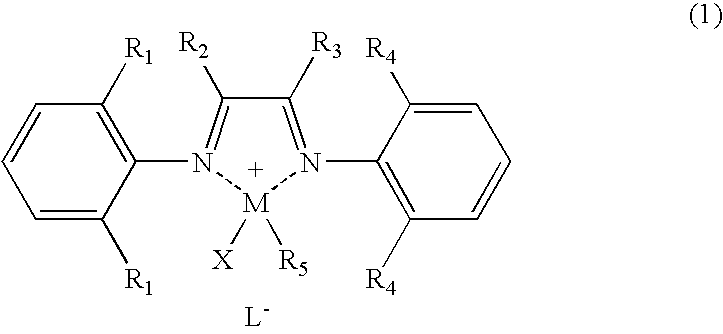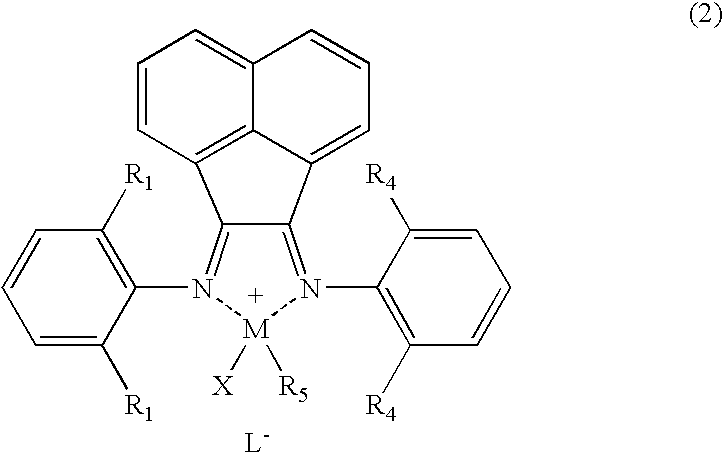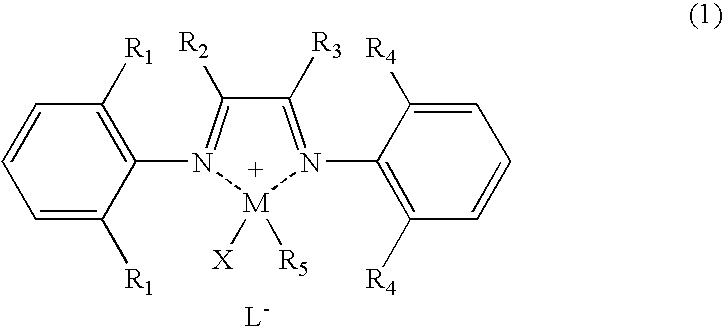Polyolefin graft copolymer
a polyolefin and copolymer technology, applied in the field of polyolefin graft copolymer, can solve the problems of lowering tensile elongation, difficult to graft-copolymerize an olefin monomer to an aqueous dispersed particle of a metallic compound, and no example of grafting by polymerization process, etc., to achieve high tensile elongation, high tensile hard hard hard hard hard
- Summary
- Abstract
- Description
- Claims
- Application Information
AI Technical Summary
Benefits of technology
Problems solved by technology
Method used
Image
Examples
synthesis example 1
(Synthesis of Coordination Polymerization Catalyst and Preparation of Catalyst Active Species)
[0087] A coordination polymerization catalyst (hereinafter, referred to as [NˆN]PdMeC) having a structure represented by the following chemical formula (3):
was synthesized by a known process described in a reference such as J. Am. Chem. Soc. 1995, vol. 117, page 6414. [NˆN]PdMeC and LiB(C6F5)4 (available from STREM Chemical Inc.) were stirred in a dried diethyl ether (available from Wako Pure Chemical Industries, Ltd.) at a room temperature for one week to precipitate LiCl, and a [NˆN]PdMe+.B(C6F5)4− complex (catalyst active species) was prepared. Thereafter, the dryed diethyl ether was concentrated and exchanged by dryed methylene chloride (available from Wako Pure Chemical Industries, Ltd.) (concentration: 40 mmol / L).
example 1
(Synthesis of Silica Modified Particle and Synthesis of Graft Copolymer of Silica Modified Particle and Olefin Monomer)
[0088] A 100 mL pear-shaped flask was charged with 12.5 mL of distilled water (available from Wako Pure Chemical Industries, Ltd.), and 81 mg of sodium dodecylsulfate (sodium laurylsulfate, available from Wako Pure Chemical Industries, Ltd.) was dissolved thereinto. Next, 12.5 mL of colloidal silica (SNOWTEX ZL available from Nissan Chemical Industries, Ltd., specific gravity: 1.296, SiO2 amount: 40.6%, average particle size: 115 nm) (6.58 g in terms of colloidal silica) was dropped while stirring. A 1N sulfuric acid aqueous solution was added thereto in a small amount to adjust pH at about 7. Deaeration under reduced pressure was effected by an aspirator, and nitrogen substitution was conducted. A temperature in an oil bath was set at 75 to 80° C., thereto was added 0.15 g of 3-acryloxypropyltrimethoxysilane (available from Shin-Etsu Silicone Co., Ltd.), and the ...
example 2
(Property of Polypropylene Resin Composition)
[0091] 20 g of a polypropylene resin (F232DC, available from Gland Polymer) and 4 g of the polyolefin graft copolymer obtained in Example 1 were kneaded by using a Laboplastomill (manufactured by Toyo Seiki Seisaku-sho, Ltd., capacity: 30 cc) at 200° C. and 100 rpm for 10 minutes, then, the obtained resin composition was pressed (conditions: 200° C., no pressure, 10 min →200° C., 50 kgf / cm2, 10 min →room temperature, 50 kgf / cm2, 5 min) to form a sheet having a thickness of about 0.7 mm, and the tensile property and wetting property were measured. The results are shown in Table 1.
PUM
| Property | Measurement | Unit |
|---|---|---|
| particle size | aaaaa | aaaaa |
| particle size | aaaaa | aaaaa |
| particle size | aaaaa | aaaaa |
Abstract
Description
Claims
Application Information
 Login to View More
Login to View More - R&D
- Intellectual Property
- Life Sciences
- Materials
- Tech Scout
- Unparalleled Data Quality
- Higher Quality Content
- 60% Fewer Hallucinations
Browse by: Latest US Patents, China's latest patents, Technical Efficacy Thesaurus, Application Domain, Technology Topic, Popular Technical Reports.
© 2025 PatSnap. All rights reserved.Legal|Privacy policy|Modern Slavery Act Transparency Statement|Sitemap|About US| Contact US: help@patsnap.com



